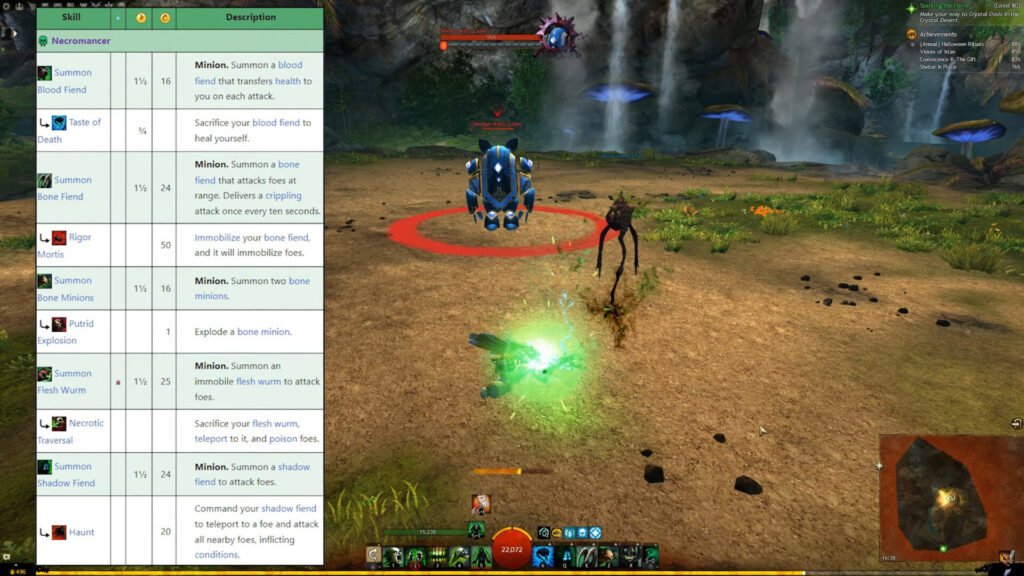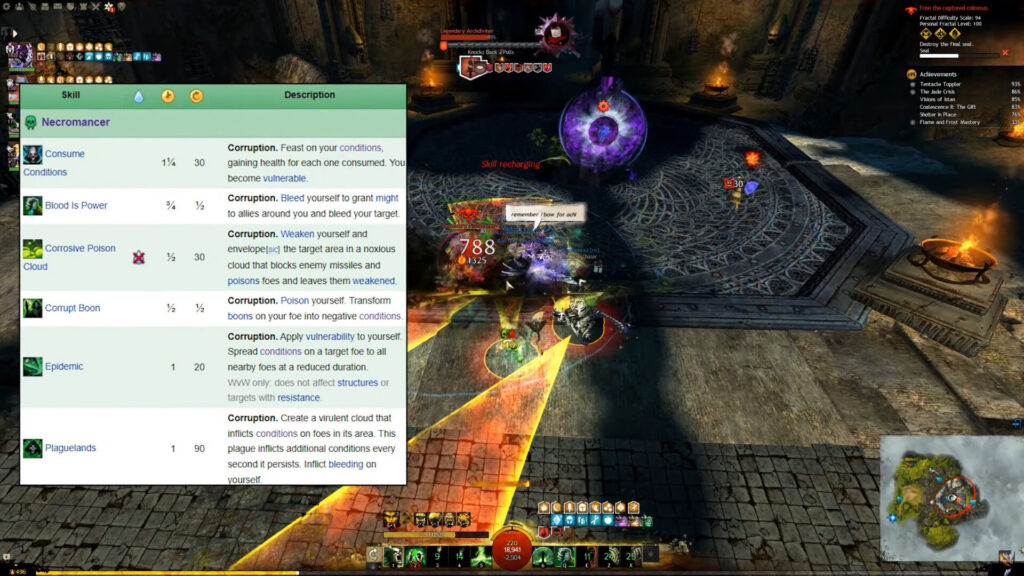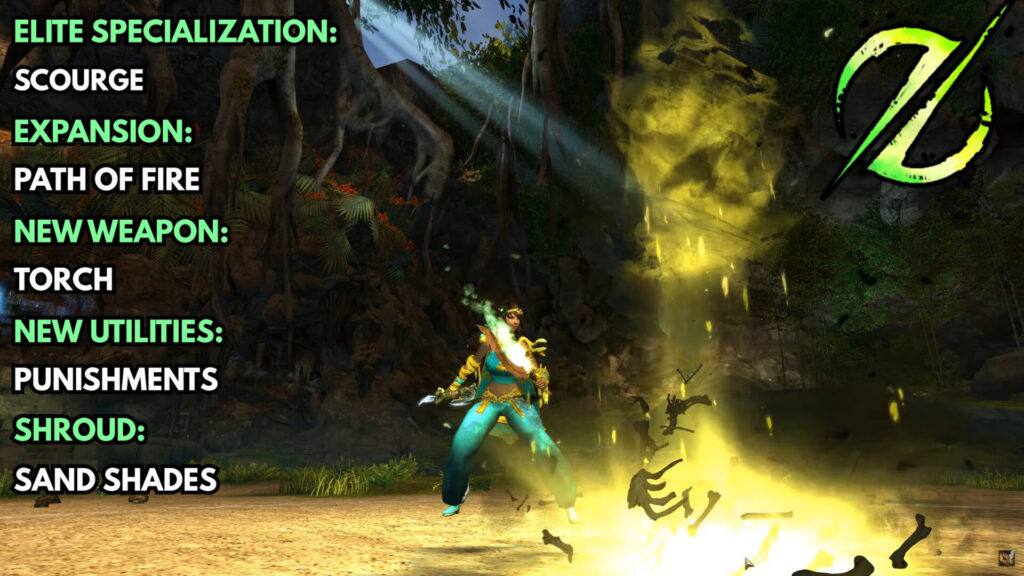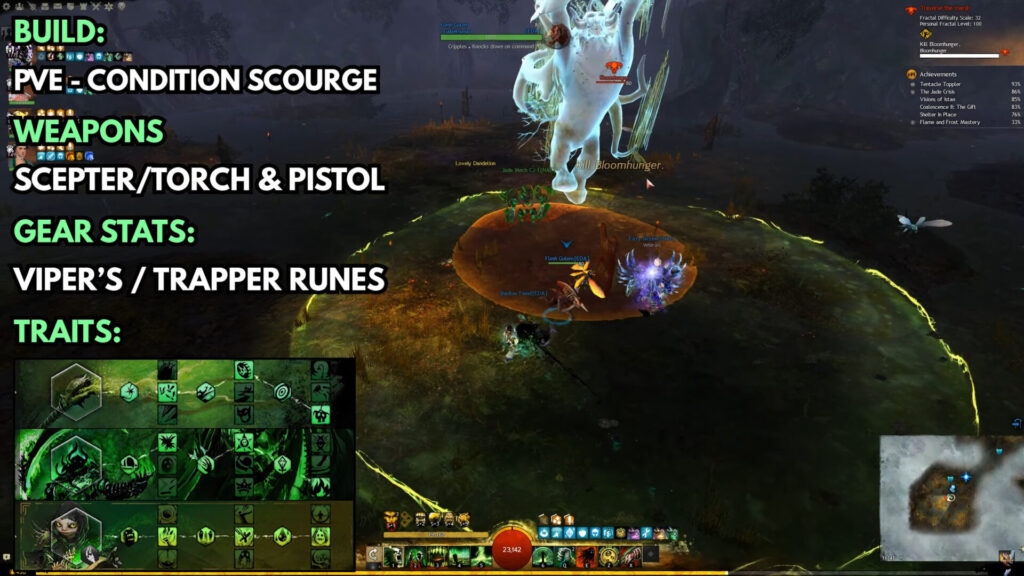The Necromancer is one of the most versatile and beginner-friendly professions one can choose in Guild Wars 2. They can summon minions, curse their enemies, and inflict damage over time. Additionally, they can support their allies by utilizing Blood Magic. But what else should you know about the Necromancer in Guild Wars 2?
The Death Shroud
Necromancers possess a unique resource known as “life force.” Life force is generated by attacking enemies and using specific skills. Necromancers can use life force to enhance their Death Shroud. You can see the amount of life force you’ve accumulated just above your skill bar. Once you’ve accumulated enough life force, you can activate the Death Shroud.

The Death Shroud takes the form of a powerful state that equips the Necromancer with a new set of skills for dealing damage and provides additional crowd control abilities. Additionally, this death shroud supplies you with an extra life bar based on the life force you’ve accumulated.
This Death Shroud can be used for dealing damage or to crowd control enemies and it can also save you when you’re low on health.
Skills
To gather life force for the Death Shroud, the Necromancer needs to use skills. You can use your basic weapon skills for direct damage, condition damage, and control.
Necromancers also have Utility Skills. Here is an overview of all the skill types without getting into the nitty-gritty of each one.
Wells
Necromancers can use Wells to support or damage a specific area. Some wells deal damage to your foes directly, while others remove buffs from your foes and turn them into conditions, making your enemies weaker.

Minions
The Necromancer can summon Minions to deal damage and protect you. You can call forth a Shadow Fiend that helps in combat. When summoned, you can activate its skill to teleport it to your target, blinding and chilling your foe. Blinding stops their next attack, and chilling slows your foe down.
You can also summon a Bone Fiend that attacks from a distance. When you use its skill again, the Bone Fiend can cripple or slow your foe down.
Minions are a great choice if you want to keep your enemies at a distance.

Signets
Signets come with passive effects that boost your condition damage or the life force you generate. Plus, you can activate them for an immediate effect.
For instance, take the Signet of Spite. It enhances your damage passively, which is pretty awesome. But you can also activate it to hit your foes with a bunch of debilitating conditions.

Spectral Skills
Spectral Skills provide the Necromancer with added defensive abilities and help enhance their life force. Spectral Armor briefly reduces the damage you take. If you get hit while the Spectral Armor effect is active, it also grants you some life force.
Spectral Walk operates in a similar way to Spectral Armor, but it additionally removes conditions and boosts your movement speed. If you activate Spectral Walk again, it will take you back to your original location where you first used Spectral Walk.

Corruption Skills
Finally, let’s talk about Corruption Skills. These skills have a downside for the Necromancer, but they hit your foes even harder.
Corrupt Boon, for instance, causes poison to you, but it removes boons from your target and transforms them into harmful effects. As for Blood is Power, it inflicts bleeding on both you and your targeted foes. But it also grants might to yourself and nearby allies, increasing your outgoing damage!

Necromancer Elite Specializations
Now, let’s touch upon the three elite specializations:
- The Reaper
- The Scourge
- The Harbinger.
A short overview is provided here, be sure to check out the dedicated professions/classes article and video.
Reaper
The Reaper elite specialization replaces the Necromancer’s Death Shroud with the Reaper’s Shroud. This new form empowers the Reaper to inflict more direct damage on nearby targets and gives them the ability to stun their enemies.
The Reaper also gains access to the Greatsword and unlocks Shouts. Shouts are instant skills that deliver immediate effects to enemies or enable the Reaper to summon minions on the spot.

Scourge
The Scourge replaces the Necromancer’s Death Shroud with Sand Shades. These shades can be placed at a specific location. They inflict conditions on nearby enemies and provide a protective barrier to nearby allies. Barrier shield your allies from harm.
The Scourge gains access to a torch and obtains Punishment skills. Punishment skills not only support your allies by granting them boons and barrier but also enhance the Scourge’s mobility, allowing them to swiftly reposition themselves.

Harbinger
The Harbinger replaces the Necromancer’s Death Shroud with the Harbinger Shroud. The Harbinger’s Shroud equips them with strong offensive and mobility skills. However, these abilities come at a cost. The Harbinger Shroud inflicts Blight, reducing maximum health. The longer the Harbinger remains in this state, the less maximum health they have. Nevertheless, you can make the most of this Blight with specific Traits and skills.
The Harbinger also gains access to a pistol and Elixirs. They can toss Elixirs at enemies to deal damage, and being within the impact area also inflicts Blight on them.

Builds
Now that you’ve learned all about the Necromancer and its Elite Specializations, let’s explore some common builds for the Necromancer. I played these myself and are my personal favourites.
Necromancer PvE Minion Master Leveling Build
- Gamemode: PvE
- Difficulty: Easy
- Build: Necromancer build on Metabattle

For a straightforward and relaxed build suitable for Free to Play (F2P) players or the Core Necromancer, consider the Minion Master build. Minion Master builds are primarily used in Open World PvE but can also be used in PvP. This build is low in intensity and doesn’t offer the highest damage output but it’s perfect if you want to progress through the story, level up your character or engage in open-world activities while enjoying a podcast or something similar.
In this build, make use of a Scepter and a Dagger as your primary weapon set, and keep a Staff as your secondary weapon set. Ensure that before you initiate combat, you summon all your minions. Avoid sacrificing your minions for damage or healing unless it’s necessary.
If you’re looking for a substantial burst of damage, consider using the Lich Form. When you activate the Lich Form, you gain access to direct damage skills and additional minion skills. It’s advisable to use this when facing a large group of enemies or a tough foe, given the lengthy cooldown of the Lich Form.
As an alternative to the Lich Form, you can take the Flesh Golem elite skill. The Flesh Golem is one of the strongest minions in Guild Wars 2 and can take a significant amount of damage for you while also possessing a powerful crowd control ability.
Necromancer PvP Build (Reaper)
- Gamemode: PvP
- Difficulty: Medium
- Build: Reaper Build on Hardstuck

Now, let’s delve into some builds that require Elite Specializations and, consequently, an expansion.
If you’re into PvP, consider playing the Condition Reaper build. This build provides the Necromancer with a significant amount of control over the battlefield while inflicting damage over time effects on your foes.
The Condition Reaper wields a Staff as their primary weapon set and a Scepter and a Dagger as their secondary weapon set. Using the skills on these weapons inflicts bleeding on your enemies, causing damage over time. It also inflicts Chill, Vulnerability, and Blind effects, which slow down your enemies, increase the damage they take, and prevent them from attacking.
Always remember to use your shouts and wells to get more control over your enemies by slowing them and preventing them from attacking. It’s essential to position yourself away from the centre of the battle and attack from a distance to minimise the damage you take.
Necromancer End Game PvE Build (Scourge)
- Gamemode: PvE
- Difficulty: Medium
- Build: Condition Scourge on Hardstuck

My personal favorite build for the Necromancer is the Condition Scourge. This build excels at inflicting condition damage, providing barrier, and granting might to your allies, enabling them to deal more damage and stay protected.
The Condition Scourge build is primarily geared for End Game PvE content like Fractals of the Mists, Raids, or Strike Missions. However, when used effectively, it can also be used in Open World PvE. In this build, the Scourge utilizes a Scepter/Torch combination as their primary weapon set and a Pistol/Torch as their secondary weapon set.
The core strategy of this build revolves around deploying your sand shades and keeping them near your enemies at all times. Using your Sand Shade skills inflicts conditions on enemies, cleanses allies from conditions, and provides them with barrier.
The Blood is Power skill offers you and your allies Might but also inflicts bleeding on the Scourge. You can then use the Sand Shade skills to cleanse this bleeding.
Your primary focus should be on your auto attacks, which apply bleeding, and the final attack in your auto attack chain delivers the most damage. Combine this with Grasping Dead for more bleeding and Devouring Darkness for additional Life Force and Torment to maximize your effectiveness.
Necromancer Roamer WvW Build (Harbinger):
- Gamemode: PvE
- Difficulty: Medium/Hard
- Build: Celestial Harbinger on Guildjen

Thinking of giving World vs. World a shot? You might want to try out this Harbinger build.
This build is designed to deal substantial condition damage to your enemies while also providing a good amount of Crowd Control. This makes it an excellent choice for roaming and for one-on-one encounters with other players.
As your main weapon set, this build uses a Pistol/Warhorn combination. For your secondary set, the build uses a Dagger/Torch combination. These skills come packed with Stun, Daze, and other Crowd Control abilities. By using these skills in the right order, you can effectively shut down an enemy and apply conditions to them.
One effective combo is to use Torch skill 5, then swap to your other weapon set and use Pistol skill 3 and Warhorn skill 4 to stun an enemy for about 4 seconds. In the meantime, be sure to employ Condition Skills in between the stuns to lower your target’s health.
Tips for playing as a Necromancer
Here are some gameplay tips for playing as a Necromancer:
- Don’t hesitate to enter your Shroud. The Shroud mechanic is strong, as it can increase the Necromancer’s damage, help control your enemies, and, most importantly, provide an extra health pool to save you when your health is low.
- When using minions, use them strategically. Minions can be a valuable way to distract and damage your enemies. Only sacrifice them when necessary.
- If you’re using a Condition Damage build, consistently reapply your conditions to maximize your outgoing damage. Conditions, such as Bleeding, stack their effectiveness or duration.
- Necromancers can provide buffs to your allies while inflicting conditions on themselves. Whenever you apply a condition, be sure to use a skill that transfers this condition to your enemy as well. For example, use Deathly Swarm on your off-hand dagger, the Plague Signet Utility Skill, or Nefarious Favor on your Sand Shade as a Scourge.
In conclusion, the Necromancer is a strong and versatile class that can be played in various ways. If you’re looking for a profession that can deal damage, apply conditions, and summon minions, then the Necromancer is the perfect choice for you.